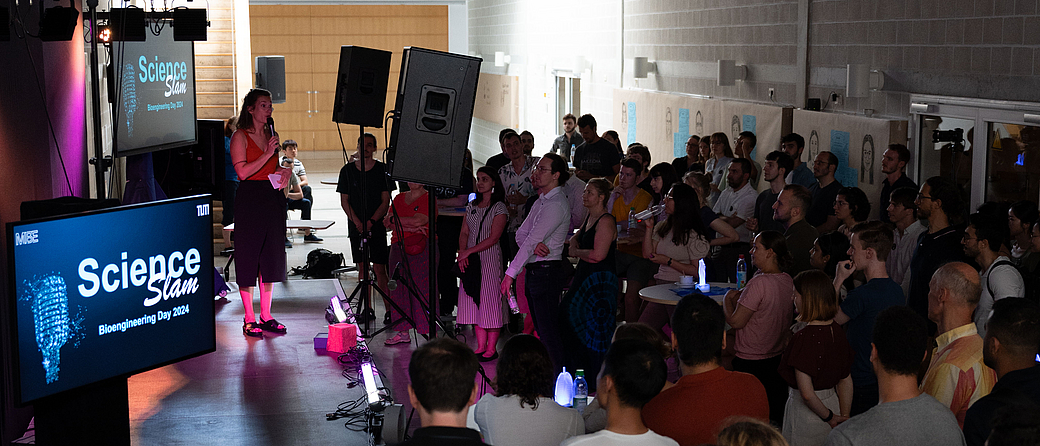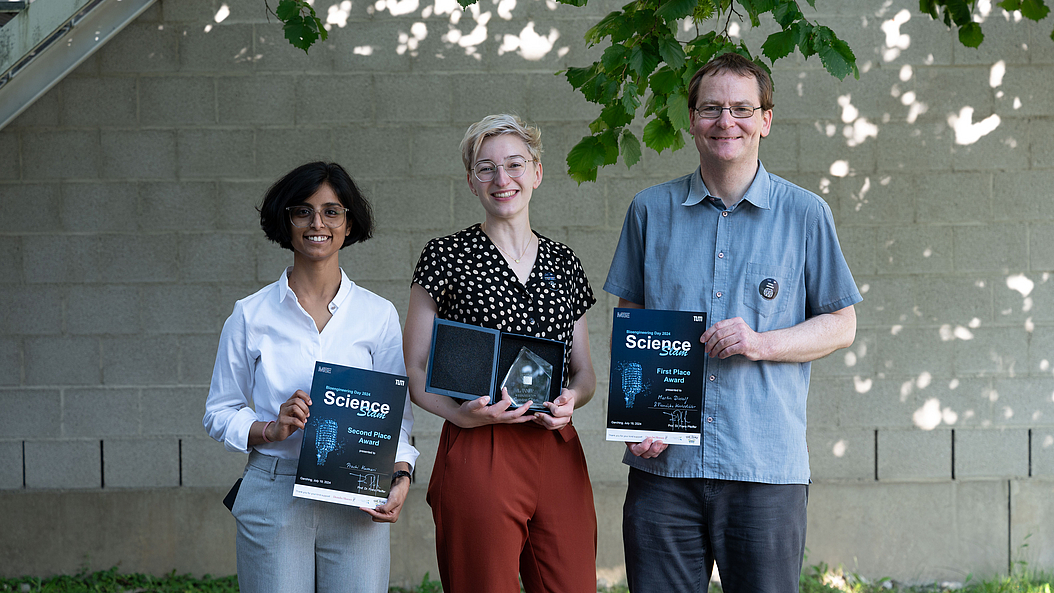Magnetoelectric nanoparticles for Frankenstein, medical imaging with polka dot patterns, and microtaxis that move between cells. On Friday, 24 July, at the third Bioengineering Day of the Munich Institute of Biomedical Engineering (MIBE) at the Technical University of Munich (TUM), researchers brought their topics to life in the form of science slams. They introduced around 130 guests to the world of neurons, robotics and biomedicine.
"Let me tell you a story of adventure, science and a bit of horror". Thunder and lightning on stage accompanied the start of Prachi Kumari's slam. The doctoral candidate is investigating tiny magnetoelectric particles. These are to be used in the brain to aid in movement control for people with mobility impairments. Using the story of Frankenstein, she took the audience on a journey into the world of nanoparticles for neurostimulation. However, unlike conventional electrodes, they are not wired to the brain in this case: The nanoparticles are injected and work wirelessly.
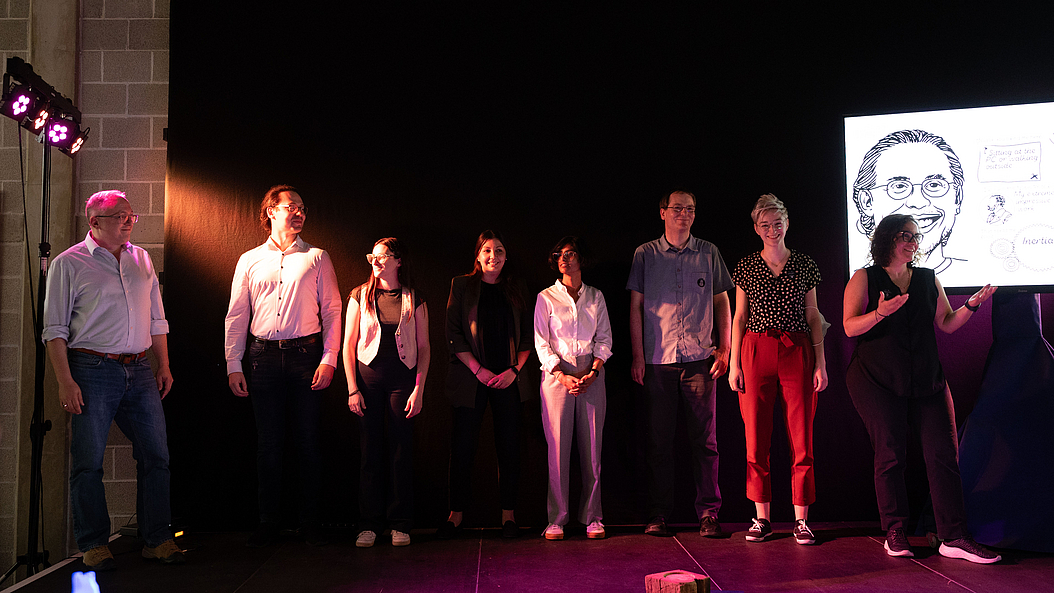
Image: Carolin Lerch / TUM
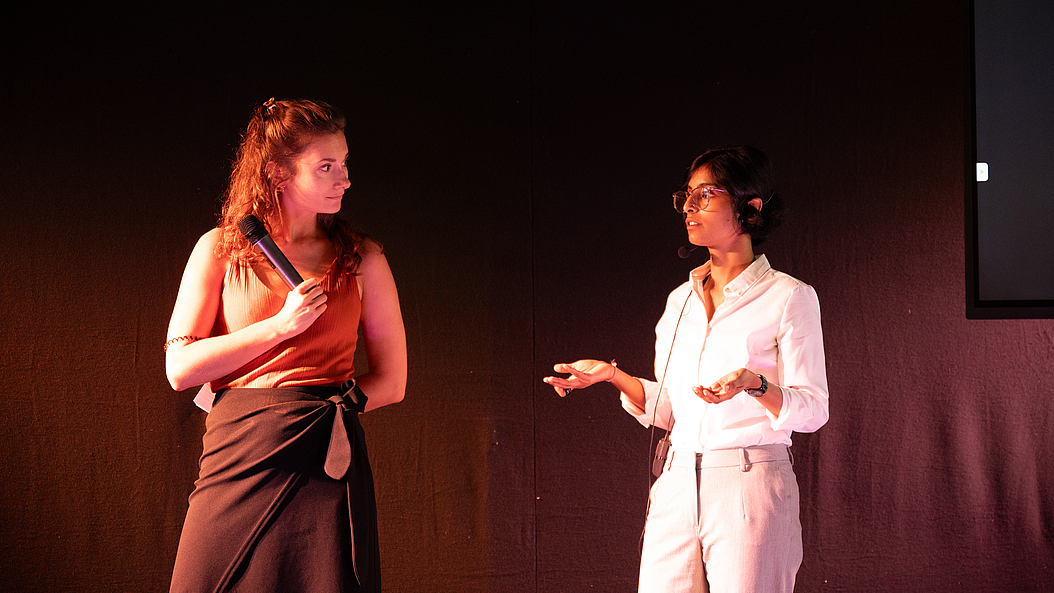
Image: Carolin Lerch / TUM
With this and five other science slams, MIBE scientists captivated the guests with humor and captivating stories about their topics. "With the Bioengineering Day, we want to bring together researchers from different fields and promote exchange between the groups in order to strengthen the axis of medicine - natural sciences - engineering at TUM," says Franz Pfeiffer, Professor of Biomedical Physics and Executive Director of MIBE.
Spying on cells on a taxi ride through the tissue
Tiny "taxis" that transport cells and collect information about them to help with cancer, for example. This was the subject of the slam by Berna Özkale Edelmann, Professor of Nano- and Microrobotics at TUM. She is developing "TACSI-microrobots" that are powered by light and move between cells. They can measure certain properties of the cells and stimulate them by a change in temperature.
In their slam "Cutting-edge without cutting", doctoral candidate Franziska Hinterdobler and Dr. Martin Dierolf demonstrated how a (golden) retriever can be used to look inside a pituitary gland without cutting it. Conventional X-rays, which are familiar to us from airports or visits to the doctor, are based on the attenuation of X-rays. This works well for bones, for example. The method presented by Dierolf and Hinterdobler - known as phase-contrast X-ray imaging - is based on the refraction of light. The team demonstrated how this works using a dotted reference pattern: if you hold a water bottle in front of the pattern, it appears distorted. This information allows researchers to draw conclusions about the sample; the entire sample can thus be examined in a three-dimensional representation without cutting.
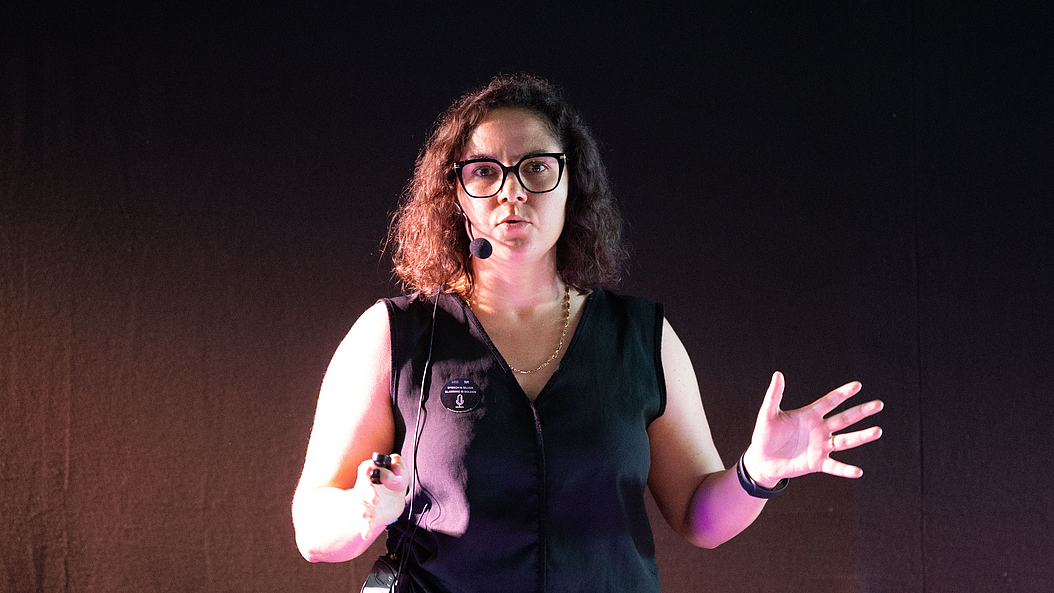
Image: Carolin Lerch / TUM
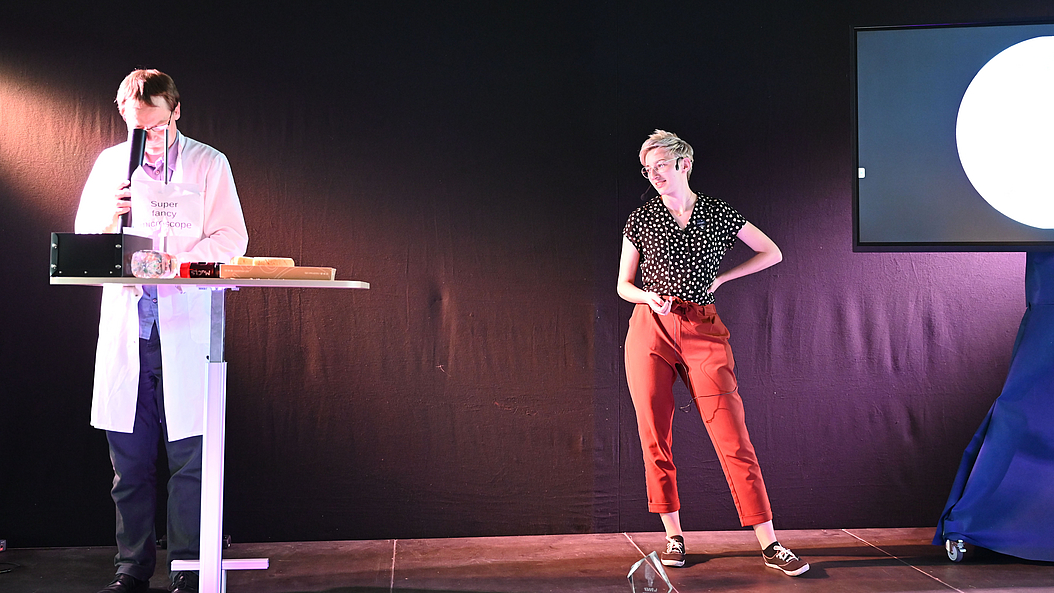
Image: Carolin Lerch / TUM
Restoring people's movement and hearing through technology
What technical support can be used to help people after amputations? Cristina Piazza, Professor of Healthcare and Rehabilitation Robotics, and Dr. Patricia Capsi-Morales are developing robotic hand prostheses. Their focus is on lightweight prostheses that move naturally, take integration into everyday life into account, and are, therefore, particularly suited to the needs of users.
Doctoral candidate Albert Croner is also researching prostheses, but for hearing. He demonstrated what hearing sounds like with a cochlear implant, i.e. a hearing prosthesis in the inner ear. What initially sounds distorted works surprisingly well in practice, as our brain is very adaptable. However, in order to make the implants even better in the future, it is important to understand the exact connection between the electrical signals of the implant and the individual neurons in the auditory nerve. This is what Croner's research is focusing on.
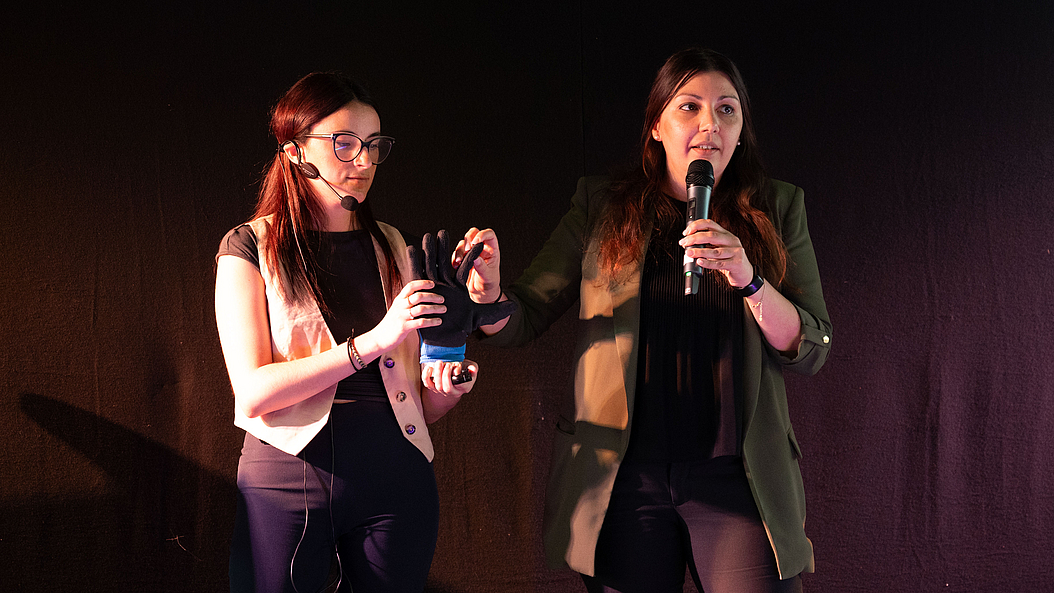
Image: Carolin Lerch / TUM
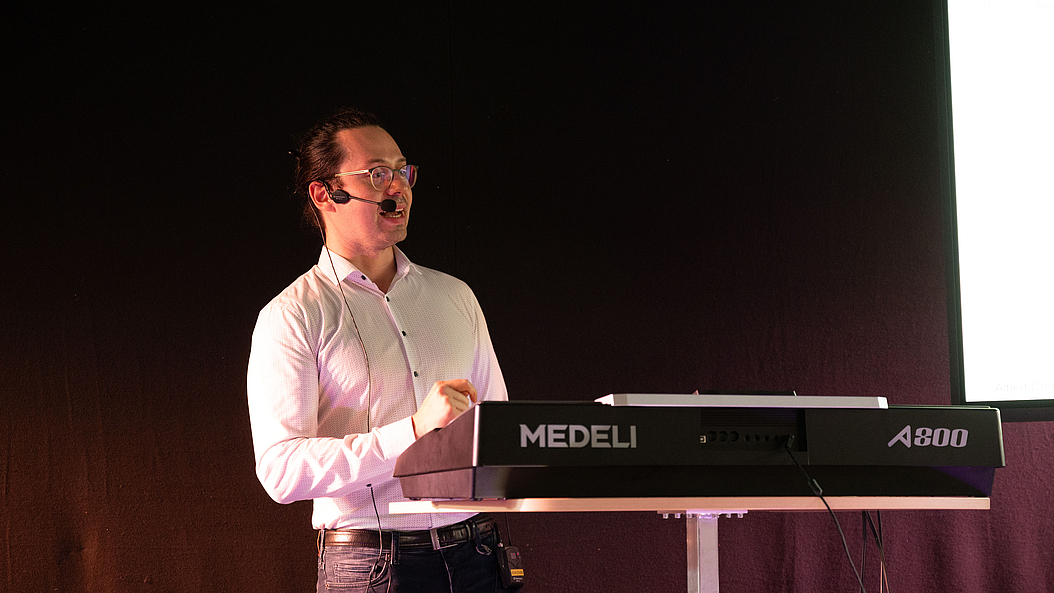
Image: Carolin Lerch / TUM
Detecting sepsis and thrombosis earlier with a new biomarker
A new biomarker to predict severe complications such as sepsis and thrombosis in COVID19. This is part of the research of Oliver Hayden, Professor of Biomedical Electronics. Take blood, dilute it a little, measure it: Within two minutes, the new technology provides significant information, including the early biomarker. This is achieved by using blood cell chit-chat, i.e. the interactions between blood cells.
Lisa Budzinski, biotechnologist, science slammer and host of ZDF's Terra Xplore, guided the guests through the event with humor and verve. And at the very end: cheering guests and loud applause for the slammers. The trophy for first place was awarded to the team Hinterdobler and Dierolf, followed by Kumari. The Bioengineering Day took place for the third time this year, with the format varying each year: from start-up pitches, scientific lectures, a panel discussion and now the first Science Slam at MIBE.
More Information
Order and title of the slams:
- Prof. Dr. Berna Özkale Edelmann: „Microrobots spying on your cells (for the greater good)”
- Franziska Hinterdobler & Dr. Martin Dierolf: „Cutting-edge without cutting“
- Prachi Kumari: „Redefining brain stimulation with magnetoelectric nanoparticles“
- Prof. Dr. Cristina Piazza & Dr. Patricia Capsi-Morales „Empowering bionics: turning disability into superpowers
- Albert Croner: „Understanding artificial hearing“
- Prof. Dr. Oliver Hayden: „Diagnosing disease severity and predicting complications of acute care COVID patients during the pandemic“
Opening: Prof. Dr. Franz Pfeiffer, Executive Director MIBE
Science Slam host: Lisa Budzinski
